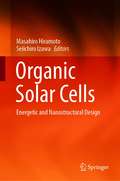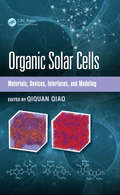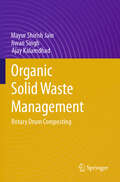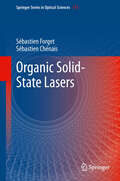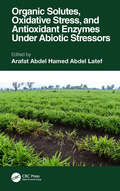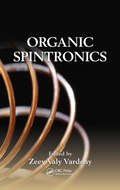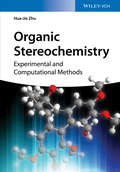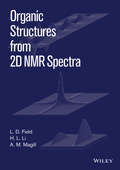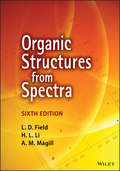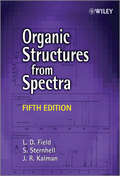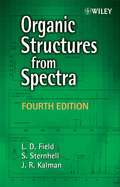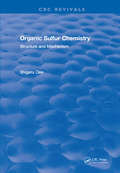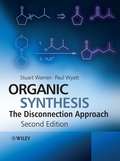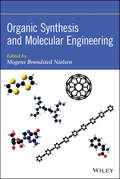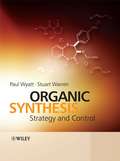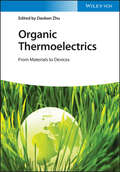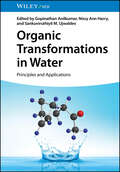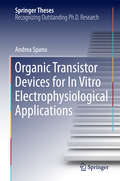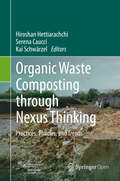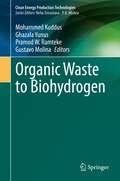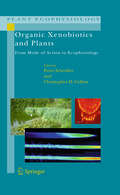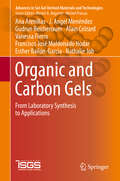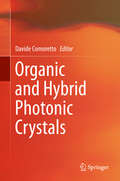- Table View
- List View
Organic Solar Cells: Energetic and Nanostructural Design
by Masahiro Hiramoto Seiichiro IzawaThis book focuses on the essential scientific ideas and breakthroughs in the last three decades for organic solar cells that have realized practical applications. The motivation for publishing this book is to explain how those essential ideas have arisen and to provide a foundation for future progress by target readers—students, novices in the field, and scientists with expertise. The main topics covered in the book include the fundamental principles and history of organic solar cells, blended junction, nanostructure control, photocurrent generation, photovoltage generation, doping, practical organic solar cells, and possible ideas for the future. The editors enthusiastically anticipate the vigorous development of the field of organic solar cells by young scientists of the next generation.
Organic Solar Cells: Materials, Devices, Interfaces, and Modeling (Devices, Circuits, and Systems #38)
by Qiquan QiaoCurrent energy consumption mainly depends on fossil fuels that are limited and can cause environmental issues such as greenhouse gas emissions and global warming. These factors have stimulated the search for alternate, clean, and renewable energy sources. Solar cells are some of the most promising clean and readily available energy sources. Plus, the successful utilization of solar energy can help reduce the dependence on fossil fuels. Recently, organic solar cells have gained extensive attention as a next-generation photovoltaic technology due to their light weight, mechanical flexibility, and solution-based cost-effective processing. Organic Solar Cells: Materials, Devices, Interfaces, and Modeling provides an in-depth understanding of the current state of the art of organic solar cell technology. Encompassing the full spectrum of organic solar cell materials, modeling and simulation, and device physics and engineering, this comprehensive text: Discusses active layer, interfacial, and transparent electrode materials Explains how to relate synthesis parameters to morphology of the photoactive layer using molecular dynamics simulations Offers insight into coupling morphology and interfaces with charge transport in organic solar cells Explores photoexcited carrier dynamics, defect states, interface engineering, and nanophase separation Covers inorganic–organic hybrids, tandem structure, and graphene-based polymer solar cells Organic Solar Cells: Materials, Devices, Interfaces, and Modeling makes an ideal reference for scientists and engineers as well as researchers and students entering the field from broad disciplines including chemistry, material science and engineering, physics, nanotechnology, nanoscience, and electrical engineering.
Organic Solid Waste Management: Rotary Drum Composting
by Jiwan Singh Ajay Kalamdhad Mayur Shirish JainThis book offers a comprehensive examination of the rotary drum composter as an effective solution for managing organic waste. With a focus on decentralized systems, it emphasizes the benefits of on-site composting to reduce waste transportation's environmental and economic costs. The book explores the underlying science and engineering principles behind the rotary drum composter, highlighting its ability to create high-quality compost in a controlled environment. Various studies are presented, detailing its successful application in handling municipal solid waste, sewage sludge, agricultural residues, and weeds. Additionally, the text delves into key factors such as temperature control, aeration, and microbial dynamics that influence the composting process. Real-world case studies from premier Indian institutions, including the IITs and NITs, illustrate rotary drum composters' technological advancements and operational efficiencies. The book is an essential resource for researchers, environmental engineers, and practitioners interested in sustainable waste management techniques. It demonstrates the efficacy of rotary drum composters in diverse scenarios and underscores the need to optimize design and cost-efficiency to promote broader adoption.
Organic Solid-State Lasers
by Sébastien Chénais Sébastien ForgetOrganic lasers are broadly tunable coherent sources, potentially compact, convenient and manufactured at low-costs. Appeared in the mid 60's as solid-state alternatives for liquid dye lasers, they recently gained a new dimension after the demonstration of organic semiconductor lasers in the 90's. More recently, new perspectives appeared at the nanoscale, with organic polariton and surface plasmon lasers. After a brief reminder to laser physics, a first chapter exposes what makes organic solid-state organic lasers specific. The laser architectures used in organic lasers are then reviewed, with a state-of-the-art review of the performances of devices with regard to output power, threshold, lifetime, beam quality etc. A survey of the recent trends in the field is given, highlighting the latest developments with a special focus on the challenges remaining for achieving direct electrical pumping of organic semiconductor lasers. A last chapter covers the applications of organic solid-state lasers.
Organic Solutes, Oxidative Stress, and Antioxidant Enzymes Under Abiotic Stressors
by Arafat Abdel Hamed Abdel LatefThis book presents evidence-based approaches and techniques used to diagnose and manage organic solutes, oxidative stress, and antioxidant enzymes in crop plants under abiotic stressors. It discusses strategies in abiotic stress tolerance including osmoregulation, osmoprotectants, and the regulation of compatible solutes and antioxidant enzymes in plants. With contributions from 49 scholars worldwide, this authoritative guide is educational for scientists working with plants and abiotic stressors. Provides comprehensive coverage of all aspects of abiotic stress, from abiotic stresses’ effects on plant growth, development, and defense mechanisms, to functionality of enzymatic and non-enzymatic antioxidant enzymes in crop plants. Outlines the dangers of reactive oxygen species. Discusses using antioxidant enzymes and antioxidant molecules in plant protection mechanisms. Edited by Arafat Abdel Hamed Abdel Latef, Professor of Plant Physiology at South Valley University, Egypt, this book is written for graduate students and scholars researching abiotic plant stressors. “The book represents an excellent strategy to understand the mechanisms and techniques of antioxidant enzymes in the plant cell under stress conditions.” – Professor Mostafa El-sheekh “Provides a thorough and detailed picture of the updated knowledge on the techniques used to manage organic solutes, oxidative stress and stress-related enzymes under abiotic stressors.” – Bhoopander Giri, Ph.D. “Will serve as an imperative source of scientific literature in the plant stress biology field.” – Narendra Singh Yadav, Ph.D. “The book has eighteen chapters written by scholars of international expertise in plant stress management.” – Dr. Sikander PAL, Senior Assistant Professor
Organic Spintronics
by Zeev Valy VardenyMajor development efforts in organic materials research has grown for an array of applications. Organic spintronics, in particular, has flourished in the area of organic magneto-transport. Reflecting the main avenues of advancement in this arena, this volume explores spin injection and manipulation in organic spin valves, the magnetic field effect in organic light-emitting diodes (OLEDs), the spin transport effect in relation to spin manipulation, organic magnets as spin injection electrodes in organic spintronics devices, the coherent control of spins in organic devices using the technique of electronically detected magnetic resonance, and the possibility of using organic spin valves as sensors.
Organic Stereochemistry
by Hua-Jie ZhuAdopting a novel approach to the topic by combining theoretical knowledge and practical results, this book presents the most popular and useful computational and experimental methods applied for studying the stereochemistry of chemical reactions and compounds. The text is clearly divided into three sections on fundamentals, spectroscopic and computational techniques, and applications in organic synthesis. The first part provides a brief introduction to the field of chirality and stereochemistry, while the second part covers the different methodologies, such as optical rotation, electronic circular dichroism, vibrational circular dicroism, and Raman spectroscopy. The third section then goes on to describe selective examples in organic synthesis, classified by reaction type, i. e. enantioselective, chemoselective and stereoselective reactions. A final chapter on total synthesis of natural products rounds off the book. A valuable reference for researchers in academia and industry working in the field of organic synthesis, computational chemistry, spectroscopy or medicinal chemistry.
Organic Structures from 2D NMR Spectra
by L. D. Field A. M. Magill H. L. LiThe derivation of structural information from spectroscopic data is now an integral part of organic chemistry courses at all Universities. Over recent years, a number of powerful two-dimensional NMR techniques (e. g. HSQC, HMBC, TOCSY, COSY and NOESY) have been developed and these have vastly expanded the amount of structural information that can be obtained by NMR spectroscopy. Improvements in NMR instrumentation now mean that 2D NMR spectra are routinely (and sometimes automatically) acquired during the identification and characterisation of organic compounds. Organic Structures from 2D NMR Spectra is a carefully chosen set of more than 60 structural problems employing 2D-NMR spectroscopy. The problems are graded to develop and consolidate a student's understanding of 2D NMR spectroscopy. There are many easy problems at the beginning of the collection, to build confidence and demonstrate the basic principles from which structural information can be extracted using 2D NMR. The accompanying text is very descriptive and focussed on explaining the underlying theory at the most appropriate level to sufficiently tackle the problems. Organic Structures from 2D NMR Spectra Is a graded series of about 60 problems in 2D NMR spectroscopy that assumes a basic knowledge of organic chemistry and a basic knowledge of one-dimensional NMR spectroscopy Incorporates the basic theory behind 2D NMR and those common 2D NMR experiments that have proved most useful in solving structural problems in organic chemistry Focuses on the most common 2D NMR techniques ? including COSY, NOESY, HMBC, TOCSY, CH-Correlation and multiplicity-edited C-H Correlation. Incorporates several examples containing the heteronuclei 31P, 15N and 19F Organic Structures from 2D NMR Spectra is a logical follow-on from the highly successful ?Organic Structures from Spectra? which is now in its fifth edition. The book will be invaluable for students of Chemistry, Pharmacy, Biochemistry and those taking courses in Organic Chemistry.
Organic Structures from Spectra
by L. D. Field H. L. Li A. M. MagillThe derivation of structural information from spectroscopic data is now an integral part of organic chemistry courses at all Universities. A critical part of any such course is a suitable set of problems to develop the students’ understanding of how organic structures are determined from spectra. The book builds on the very successful teaching philosophy of learning by hands-on problem solving; carefully graded examples build confidence and develop and consolidate a student’s understanding of organic spectroscopy. Organic Structures from Spectra, 6th Edition is a carefully chosen set of about 250 structural problems employing the major modern spectroscopic techniques, including Mass Spectrometry, 1D and 2D 13C and 1H NMR Spectroscopy and Infrared Spectroscopy. There are 25 problems specifically dealing with the interpretation of spin–spin coupling in proton NMR spectra and 10 problems based on the quantitative analysis of mixtures using proton and carbon NMR spectroscopy. The accompanying text is descriptive and only explains the underlying theory at a level that is sufficient to tackle the problems. The text includes condensed tables of characteristic spectral properties covering the frequently encountered functional groups. The examples themselves have been selected to include all important structural features and to emphasise connectivity arguments and stereochemistry. Many of the compounds were synthesised specifically for this book. In this collection, there are many additional easy problems designed to build confidence and to demonstrate basic principles. The Sixth Edition of this popular textbook: now incorporates many new problems using 2D NMR spectra (C–H Correlation spectroscopy, HMBC, COSY, NOESY and TOCSY); has been expanded and updated to reflect the new developments in NMR spectroscopy; has an additional 40 carefully selected basic problems; provides a set of problems dealing specifically with the quantitative analysis of mixtures using NMR spectroscopy; features proton NMR spectra obtained at 200, 400 and 600 MHz and 13C NMR spectra including routine 2D C–H correlation, HMBC spectra and DEPT spectra; contains a selection of problems in the style of the experimental section of a research paper; includes examples of fully worked solutions in the appendix; has a complete set of solutions available to instructors and teachers from the authors. Organic Structures from Spectra, Sixth Edition will prove invaluable for students of Chemistry, Pharmacy and Biochemistry taking a first course in Organic Chemistry.
Organic Structures from Spectra
by S. Sternhell L. D. Field J. R. KalmanThe derivation of structural information from spectroscopic data is now an integral part of organic chemistry courses at all Universities. A critical part of any such course is a suitable set of problems to develop the student’s understanding of how structures are determined from spectra. Organic Structures from Spectra, Fifth Edition is a carefully chosen set of more than 280 structural problems employing the major modern spectroscopic techniques, a selection of 27 problems using 2D-NMR spectroscopy, more than 20 problems specifically dealing with the interpretation of spin-spin coupling in proton NMR spectra and 8 problems based on the quantitative analysis of mixtures using proton and carbon NMR spectroscopy. All of the problems are graded to develop and consolidate the student’s understanding of organic spectroscopy. The accompanying text is descriptive and only explains the underlying theory at a level which is sufficient to tackle the problems. The text includes condensed tables of characteristic spectral properties covering the frequently encountered functional groups. The examples themselves have been selected to include all important common structural features found in organic compounds and to emphasise connectivity arguments. Many of the compounds were synthesised specifically for this purpose. There are many more easy problems, to build confidence and demonstrate basic principles, than in other collections. The fifth edition of this popular textbook: • includes more than 250 new spectra and more than 25 completely new problems; • now incorporates an expanded suite of new problems dealing with the analysis of 2D NMR spectra (COSY, C H Correlation spectroscopy, HMBC, NOESY and TOCSY); • has been expanded and updated to reflect the new developments in NMR and to retire older techniques that are no longer in common use; • provides a set of problems dealing specifically with the quantitative analysis of mixtures using NMR spectroscopy; • features proton NMR spectra obtained at 200, 400 and 600 MHz and 13C NMR spectra include DEPT experiments as well as proton-coupled experiments; • contains 6 problems in the style of the experimental section of a research paper and two examples of fully worked solutions. Organic Structures from Spectra, Fifth Edition will prove invaluable for students of Chemistry, Pharmacy and Biochemistry taking a first course in Organic Chemistry. Contents Preface Introduction Ultraviolet Spectroscopy Infrared Spectroscopy Mass Spectrometry Nuclear Magnetic Resonance Spectroscopy 2DNMR Problems Index Reviews from earlier editions “Your book is becoming one of the “go to” books for teaching structure determination here in the States. Great work!” “…I would definitely state that this book is the most useful aid to basic organic spectroscopy teaching in existence and I would strongly recommend every instructor in this area to use it either as a source of examples or as a class textbook”. Magnetic Resonance in Chemistry “Over the past year I have trained many students using problems in your book - they initially find it as a task. But after doing 3-4 problems with all their brains activities... working out the rest of the problems become a mania. They get addicted to the problem solving and every time they solve a problem by themselves, their confident level also increases.” “I am teaching the fundamentals of Molecular Spectroscopy and your books represent excellent sources of spectroscopi
Organic Structures from Spectra
by L. D. Field S. Sternhell John R. KalmanOrganic Structures from Spectra, Fourth Edition consists of a carefully selected set of over 300 structural problems involving the use of all the major spectroscopic techniques. The problems are graded to develop and consolidate the student's understanding of Organic Spectroscopy, with the accompanying text outlining the basic theoretical aspects of major spectroscopic techniques at a level sufficient to tackle the problems.Specific changes for the new edition will includeA significantly expanded section on 2D NMR spectroscopy focusing on COSY, NOESY and CH-CorrelationIncorporating new material into some tables to provide extra characteristic data for various classes of compoundsAdditional basic information on how to solve spectroscopic problemsProviding new problems within the area of 10 2D NMR spectroscopyMore problems at the 'simpler' end of the rangeAs with previous editions, this book combines basic theory, practical advice and sensible approaches to solving spectra problems. It will therefore continue to prove invaluable to students studying organic spectroscopy across a range of disciplines.
Organic Sulfur Chemistry: Structure And Mechanism
by Shigeru OaeThis volume contains fundamental knowledge regarding the structure and mechanisms of organic sulfur chemistry. Topics include sulfur bondings, effects of sulfur groups, stereochemistry around sulfur, substitution, ligand coupling within s-sulfurane, oxidation, reduction and rearrangement. References in this work total over 2,300. Anyone with an interest in organic sulfur chemistry will find this book to be fascinating reading.
Organic Synthesis
by Paul Wyatt Stuart WarrenOrganic Synthesis: Strategy and Control is the long-awaited sequel to Stuart Warren's bestseller Organic Synthesis: The Disconnection Approach, which looked at the planning behind the synthesis of compounds. This unique book now provides a comprehensive, practical account of the key concepts involved in synthesising compounds and focuses on putting the planning into practice.The two themes of the book are strategy and control: solving problems either by finding an alternative strategy or by controlling any established strategy to make it work. The book is divided into five sections that deal with selectivity, carbon-carbon single bonds, carbon-carbon double bonds, stereochemistry and functional group strategy.A comprehensive, practical account of the key concepts involved in synthesising compoundsTakes a mechanistic approach, which explains reactions and gives guidelines on how reactions might behave in different situationsFocuses on reactions that really work rather than those with limited applicationContains extensive, up-to-date references in each chapterStudents and professional chemists familiar with Organic Synthesis: The Disconnection Approach will enjoy the leap into a book designed for chemists at the coalface of organic synthesis.
Organic Synthesis Using Transition Metals
by Roderick BatesTransition metals open up new opportunities for synthesis, because their means of bonding and their reaction mechanisms differ from those of the elements of the s and p blocks. In the last two decades the subject has mushroomed - established reactions are seeing both technical improvements and increasing numbers of applications, and new reactions are being developed. The practicality of the subject is demonstrated by the large number of publications coming from the process development laboratories of pharmaceutical companies, and its importance is underlined by the fact that three Nobel prizes have been awarded for discoveries in this field in the 21st Century already.Organic Synthesis Using Transition Metals, 2nd Edition considers the ways in which transition metals, as catalysts and reagents, can be used in organic synthesis, both for pharmaceutical compounds and for natural products. It concentrates on the bond-forming reactions that set transition metal chemistry apart from "classical" organic chemistry. Each chapter is extensively referenced and provides a convenient point of entry to the research literature. Topics covered include:introduction to transition metals in organic synthesiscoupling reactionsC-H activationcarbonylative coupling reactionsalkene and alkyne insertion reactionselectrophilic alkene and alkyne complexesreactions of alkyne complexescarbene complexesh3- or p-allyl -allyl complexesdiene, dienyl and arene complexescycloaddition and cycloisomerisation reactionsFor this second edition the text has been extensively revised and expanded to reflect the significant improvements and advances in the field since the first edition, as well as the large number of new transition metal-catalysed processes that have come to prominence in the last 10 years - for example the extraordinary progress in coupling reactions using "designer" ligands, catalysis using gold complexes, new opportunities arising from metathesis chemistry, and C-H activation - without neglecting the well established chemistry of metals such as palladium.Organic Synthesis Using Transition Metals, 2nd Edition will find a place on the bookshelves of advanced undergraduates and postgraduates working in organic synthesis, catalysis, medicinal chemistry and drug discovery. It is also useful for practising researchers who want to refresh and enhance their knowledge of the field.
Organic Synthesis and Molecular Engineering
by Mogens Brøndsted NielsenThe theory, methods, and practices needed to build molecules and supramolecular systemsUsing a synthetic approach to organic materials chemistry, this book sets forth tested and proven methods and practices that make it possible to engineer organic molecules offering special properties and functions. Throughout the book, plenty of real-world examples demonstrate the countless possibilities of creating one-of-a-kind molecules and supramolecular systems to support a broad range of applications. The book explores applications in both materials and bioorganic chemistry, including molecular electronics, energy storage, sensors, nanomedicine, and enzyme engineering.Organic Synthesis and Molecular Engineering consists of fourteen chapters, each one contributed by one or more leading international experts in the field. The contributions are based on a thorough review and analysis of the current literature as well as the authors' firsthand experience in the lab engineering new organic molecules. Designed as a practical lab reference, the book offers:Tested and proven synthetic approaches to organic materials chemistryMethods and practices to successfully engineer functionality into organic moleculesExplanations of the principles and concepts underlying self-assembly and supramolecular chemistryGuidance in selecting appropriate structural units used in the design and synthesis of functional molecules and materialsCoverage of the full range of applications in materials and bioorganic chemistryA full chapter on graphene, a new topic generating intense researchOrganic Synthesis and Molecular Engineering begins with core concepts, molecular building blocks, and synthetic tools. Next, it explores molecular electronics, supramolecular chemistry and self-assembly, graphene, and photoresponsive materials engineering. In short, it offers everything researchers need to fully grasp the underlying theory and then build new molecules and supramolecular systems.
Organic Synthesis: Strategy and Control
by Paul Wyatt Stuart WarrenOrganic Synthesis: Strategy and Control is the long-awaited sequel to Stuart Warren's bestseller Organic Synthesis: The Disconnection Approach, which looked at the planning behind the synthesis of compounds. This unique book now provides a comprehensive, practical account of the key concepts involved in synthesising compounds and focuses on putting the planning into practice. The two themes of the book are strategy and control: solving problems either by finding an alternative strategy or by controlling any established strategy to make it work. The book is divided into five sections that deal with selectivity, carbon-carbon single bonds, carbon-carbon double bonds, stereochemistry and functional group strategy. * A comprehensive, practical account of the key concepts involved in synthesising compounds * Takes a mechanistic approach, which explains reactions and gives guidelines on how reactions might behave in different situations * Focuses on reactions that really work rather than those with limited application * Contains extensive, up-to-date references in each chapter Students and professional chemists familiar with Organic Synthesis: The Disconnection Approach will enjoy the leap into a book designed for chemists at the coalface of organic synthesis.
Organic Thermoelectrics: From Materials to Devices
by Daoben ZhuOrganic Thermoelectrics Enables readers to understand the development and applications of organic thermoelectric conversion, including fundamentals and experimental breakthroughs Organic Thermoelectrics: From Materials to Devices introduces organic thermoelectric materials to devices in a systematic manner, covering the development of organic thermoelectric materials, followed by a discussion on the fundamental mechanism of thermoelectric conversion, design strategy, and advances in different materials, device fabrication, and characterizations of thermoelectric parameters. In Organic Thermoelectrics: From Materials to Devices, readers can expect to find detailed information on: Fundamentals of thermoelectric (TE) conversion, development of organic thermoelectric (OTE) fields and mechanisms, and basic physical processes in carrier transport and thermal transport for TE conversion Recent development and key strategies to develop p-type, n-type, and composite/hybrid OTE materials Basic mechanisms, fundamental requirements, and recent advances of doping for OTE applications, plus geometries and construction methods of OTE devices Theoretical and experimental advances in single molecular TE devices, together with the recent development in related detection methods Powered by worldwide innovative research results in the past ten years and strongly supported by many collaborators, Organic Thermoelectrics is a comprehensive reference on the subject and is invaluable for scientists and students in chemistry, materials, and engineering.
Organic Transformations in Water: Principles and Applications
by Gopinathan Anilkumar Nissy Ann Harry Sankuviruthiyil M. UjwaldevHarness sustainable, environmentally friendly chemical processes with this timely volume Green chemistry has played a leading role in the broader search for environmentally sustainable industry. One of its most important goals is the shift from volatile, hazardous organic solvents to environmentally friendly ones, of which by far the most promising is water. Cultivating organic transformations using water as a solvent is one of the most crucial steps towards the creation of green, sustainable chemical production processes. Organic Transformations in Water provides a cutting-edge overview of water as a reaction medium for synthesis and catalysis. After a brief introduction, the book moves through each of the most important classes of organic transformation before concluding with a survey of industrial applications. The book will also cover: Chemistry and physicochemical aspects of “on-water” and “in-water” reactionsC–H activation, metathesis, nucleophilic addition and substitution, oxidation and reduction, and many moreAsymmetric organic reactions in waterApplications in organocatalysis, electrocatalysis, and photocatalysis Timely and comprehensive, Organic Transformations in Water is a must-own volume for researchers and industry professionals looking to revolutionize their work in a sustainable way.
Organic Transistor Devices for In Vitro Electrophysiological Applications
by Andrea SpanuThis thesis reports on a novel system forextracellular recordings of the activity of excitable cells, which relies on anorganic, charge-modulated field-effect transistor (FET) called OCMFET. Thebook shows how, thanks to the intrinsic biocompatibility, lightness, andinexpensiveness of the material used, this new system is able to overcome severalproblems typical of of "classic" electronic andbioelectronic. Itprovides a full description of the system, together with a comprehensive reportof the successful experimental trials carried out on both cardiac and nervecells, and a concise yet comprehensive overview of bioelectronic interfaces andorganic sensors for electrophysiological applications.
Organic Waste Composting through Nexus Thinking: Practices, Policies, and Trends
by Hiroshan Hettiarachchi Kai Schwärzel Serena CaucciOrganic waste composting is another excellent example to demonstrate the power and the benefits of nexus thinking. Even though organic waste composting itself is not a new topic, those who want to start a new project or align an ongoing project with nexus thinking, find it difficult to gather the necessary information. With nine case studies from four continents, this book aims to fill above gap in literature. While current literature on composting is often found to be limited to either soil/agriculture sector or waste management sector, this book presents a combined point of view. This open access book starts with an introductory chapter that describes the need to bring the waste management aspects and soil nutrient management aspects of compost production into one integrated theme. The relevance of nexus thinking and the Sustainable Development Goals (SDGs) are also presented in this introduction. The first three chapters after the introduction covers composting from the solid waste management and its policy aspects, taking examples from three developing countries. The next three examples are mostly about the benefits composting can provide to the soil and agriculture. These examples are also from three developing countries, but with a mixture of urban as well as rural settings. Last three chapters present more insight into the latest developments taking examples from Europe, as well as new methods adapted from the traditional styles from Africa.
Organic Waste to Biohydrogen (Clean Energy Production Technologies)
by Gustavo Molina Mohammed Kuddus Pramod W. Ramteke Ghazala YunusThis book provides an updated knowledge on the biohydrogen production from industrial and municipal organic waste materials. Microbes are increasingly being included in the hydrogen based biofuel production and this book covers the processes and protocols for biohydrogen production. There is an urgent need of alternative energy research to fulfill the global energy demand. Biohydrogen is a promising source of sustainable and clean energy as it harnessed by biological means. Biohydrogen may be produced by utilizing different waste materials as a substrate, and by optimization of various parameters of bioreactors such as temperature, pH, partial pressure etc. The waste materials used in hydrogen production are categorized as agricultural waste, municipal waste, industrial waste, and other hazardous wastes. Biohydrogen production from wastes materials opened a new opportunity for the widespread use of everlasting renewable energy source. This book is useful for professional scientists, academicians, biotechnologist and environmentalist along with research scholars in various biotechnology and bioenergy industries by addressing the latest research going on in the field of renewal bioenergy production from waste and their global impact on the environment.
Organic Xenobiotics and Plants
by Christopher D. Collins Peter SchröderNatural and agro-ecosystems are frequently exposed to natural or synthetic substances, which, while they have no direct nutritional value or significance in metabolism, may negatively affect plant functioning. These, xenobiotics, may originate from both natural (fires, volcano eruptions, soil or rock erosion, biodegradation) and anthropogenic (air and soil pollution, herbicides) sources. And, while affected plants have only a limited number of possibilities for avoiding accumulation of these compounds, they do exhibit several enzymatic reactions for detoxification including oxidation, reduction, hydrolysis and conjugation reactions. In agro-ecosystems in particular these mechanisms have great significance in relation to herbicide detoxification and tolerance. In this volume an international group of experts present an overview of the nature and distribution of organic xenobiotics, including their uptake, effects on plant functioning and detoxification mechanisms. The particular significance of glutathione S-transferases in bio-indication and bio-monitoring, and in the detoxification of volatile organic air pollutants and herbicides is evaluated, and their potential significance in phytoremediation and bioaccumulation will be discussed. This volume will be of interest to a wide audience, from graduate students to senior researchers in a wide range of disciplines including plant ecology, plant biochemistry, agriculture and environmental management. It will also be of practical interest to environmentalists, policy makers and resource managers.
Organic and Carbon Gels: From Laboratory Synthesis to Applications (Advances in Sol-Gel Derived Materials and Technologies)
by Ana Arenillas J. Angel Menéndez Gudrun Reichenauer Alain Celzard Vanessa Fierro Francisco José Maldonado Hodar Esther Bailόn-Garcia Nathalie JobThis expert volume provides specialized coverage of the current state of the art in carbon gels. Carbon gels represent a promising class of materials with high added value applications and many assets, like the ability to accurately tailor their structure, porosity, and surface composition and easily dope them with numerous species. The ability to obtain them in custom shapes, such as powder, beads, monoliths, or impregnated scaffolds opens the way towards numerous applications, including catalysis, adsorption, and electrochemical energy storage, among others. Nevertheless, it remains a crucial question as to which design synthesis and manufacturing processes are viable from an economic and environmental point of view. The book represents the perspectives of renowned specialists in the field, specially invited to conduct a one-day workshop devoted to carbon gels as part of the 19th International Sol-Gel Conference, SOL-GEL 2017, held on September 3rd, 2017 in Liège, Belgium.Addressing properties and synthesis through applications and industry outlook, this book represents essential reading for advanced graduate students through practicing researchers interested in these exciting materials.
Organic and Hybrid Photonic Crystals
by Davide ComorettoThis book provides a multidisciplinary perspective (ranging from chemistry to physics and biology) of the current research and applications of organic and hybrid photonic crystals. The authors detail the chemical and physical tools used to develop organic photonic crystals, explain methods for engineering new nano-structures, and propose novel physical phenomena or technological applications based on such materials. Organic and Hybrid Photonic Crystal lasers, sensors, photovoltaic devices and stimuli responsive devices are discussed.
